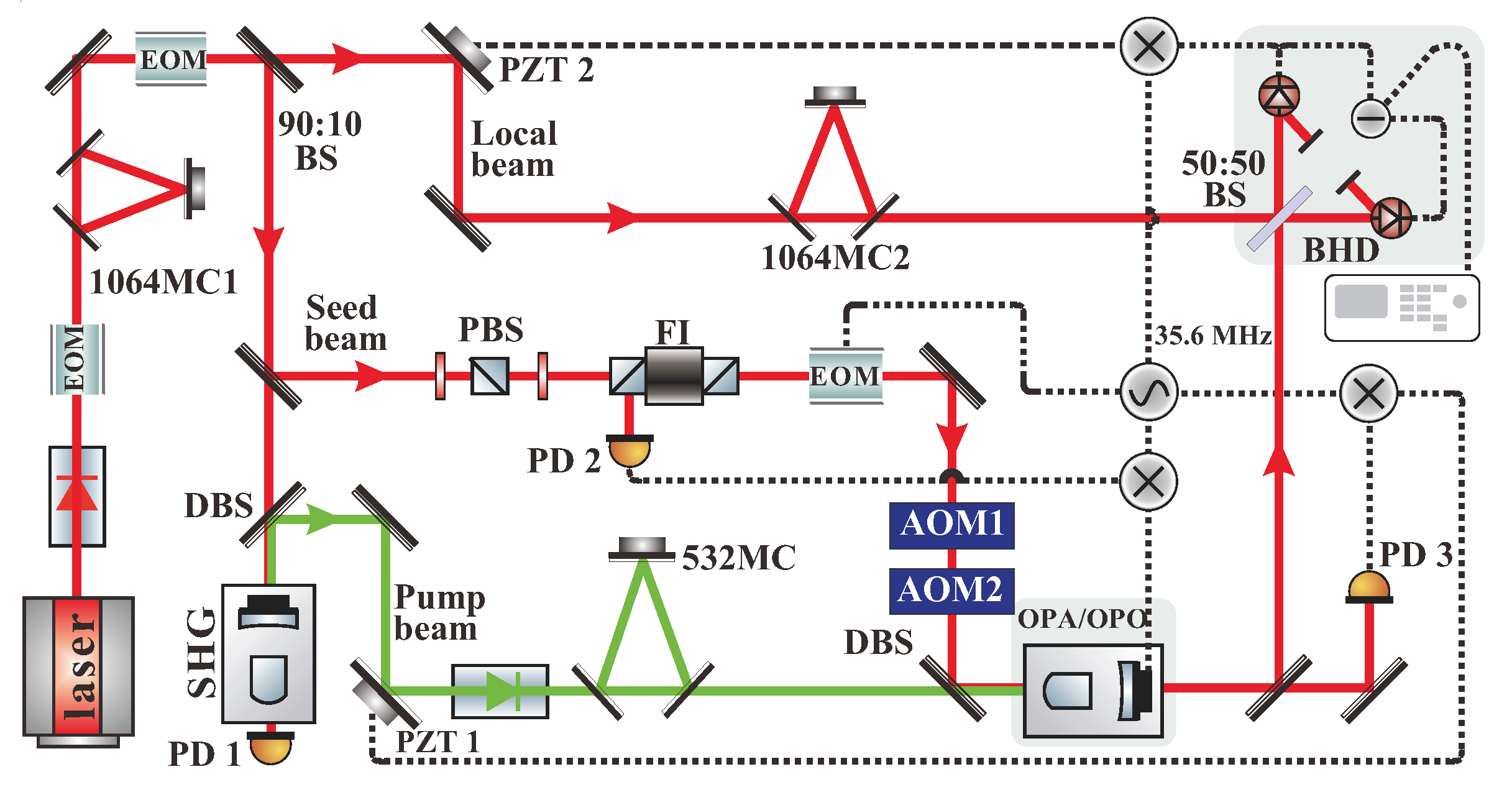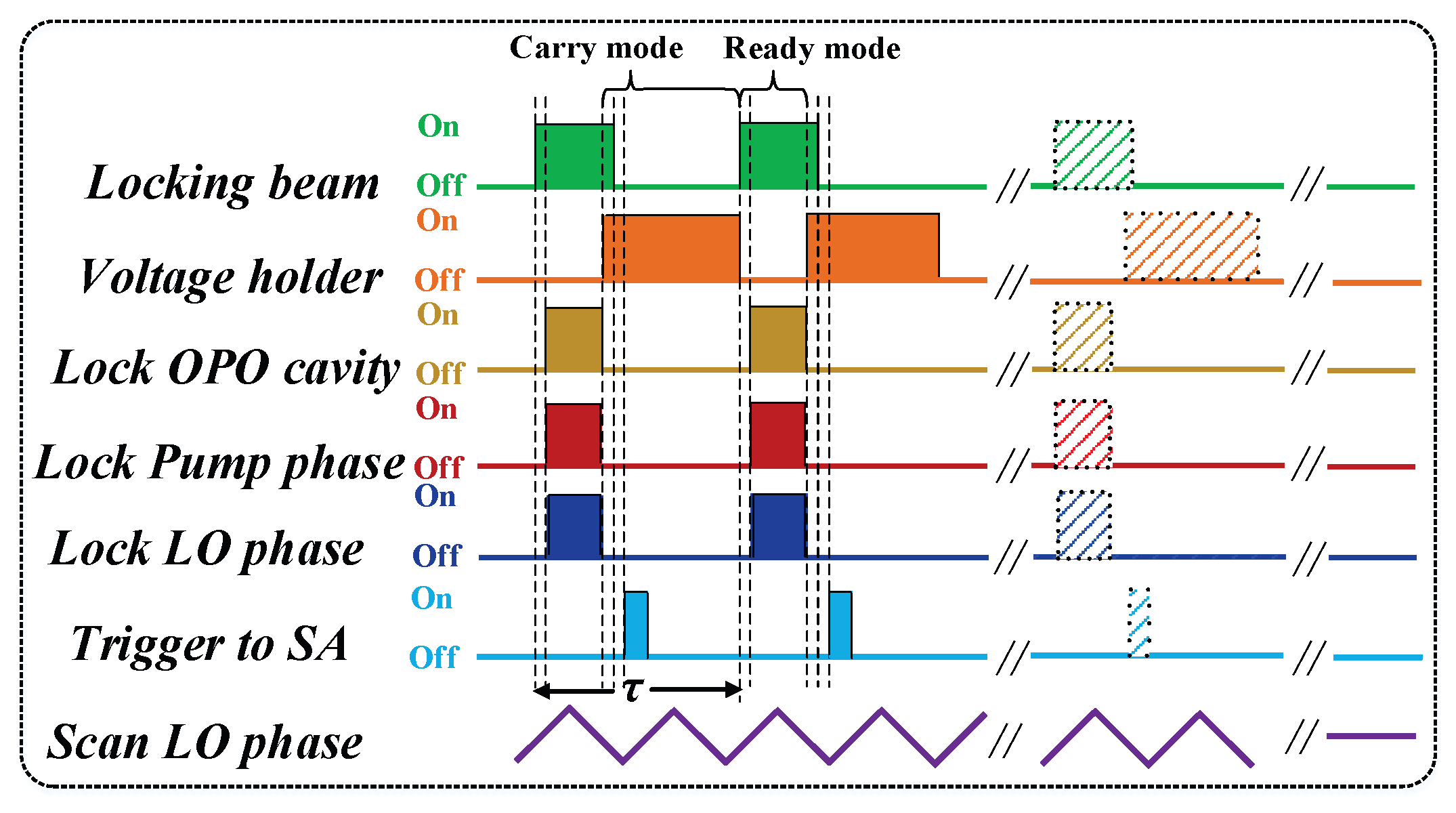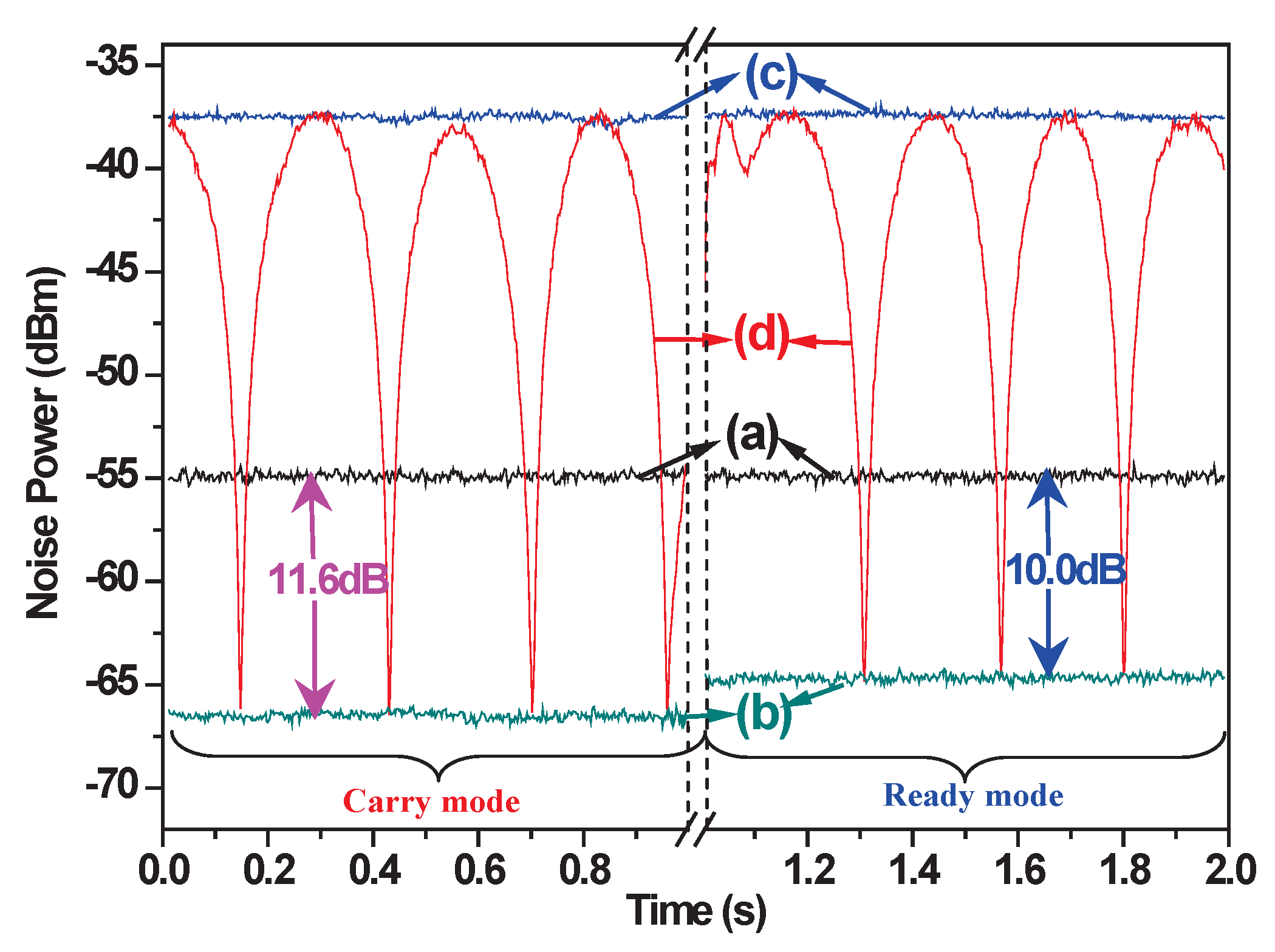Utilizing Sequential Control Scheme to Stabilize Squeezed Vacuum States
Abstract
:1. Introduction
2. Experimental Setup
3. FPGA Implementation of Sequential Control Scheme
4. Experimental Process and Results
5. Conclusions
Author Contributions
Funding
Conflicts of Interest
References
- Schrödinger, E. Der stetige Übergang von der Mikro-zur Makromechanik. Naturwissenschaften 1926, 14, 664. [Google Scholar] [CrossRef]
- Kennard, E.H. Zur Quantenmechanik einfacher Bewegungstypen. Zeitschrift für Physik 1927, 44, 326. [Google Scholar] [CrossRef]
- Darwin, C.G. Free motion in the wave mechanics. Proc. R. Soc. Lond. Ser. A 1927, 117, 258. [Google Scholar] [CrossRef]
- Caves, C.M. Quantum-mechanical noise in an interferometer. Phys. Rev. D 1981, 23, 1693. [Google Scholar] [CrossRef]
- Kolobov, M.I.; Kumar, P. Sub-shot-noise microscopy: Imaging of faint phase objects with squeezed light. Opt. Lett. 1993, 18, 849. [Google Scholar] [CrossRef]
- Lu, B.Z.; Feng, S.W.B.; Kang, M.H.; Qin, F. Experimental Study on the Imaging of the Squeezed State Light with −4.93 dB Quantum-Noise Reduction at 1064 nm. Adv. Mater. Res. 2012, 571, 439. [Google Scholar] [CrossRef]
- Taylor, M. Subdiffraction-Limited Quantum Imaging of a Living Cell. In Quantum Microscopy of Biological Systems; Springer International Publishing: Berlin/Heidelberg, Germany, 2015; p. 153. [Google Scholar]
- Polzik, E.S.; Carri, J.; Kimble, H.J. Spectroscopy with squeezed light. Phys. Rev. Lett. 1992, 68, 3020. [Google Scholar] [CrossRef]
- Li, Y.Q.; Lynam, P.; Xiao, M.; Edwards, P.J. Sub-shot-noise laser Doppler anemometry with amplitude-squeezed light. Phys. Rev. Lett. 1997, 78, 3105. [Google Scholar] [CrossRef]
- Dutton, Z.; Shapiro, J.H.; Guha, S. LADAR resolution improvement using receivers enhanced with squeezed-vacuum injection and phase-sensitive amplification. J. Opt. Soc. Am. B 2010, 27, 63. [Google Scholar] [CrossRef]
- Gottesman, D.; Preskill, J. Secure quantum key distribution using squeezed states. In Quantum Information with Continuous Variables; Springer: Dordrecht, The Netherlands, 2003; p. 317. [Google Scholar]
- Feng, J.; Wan, Z.; Li, Y.; Zhang, K. Distribution of continuous variable quantum entanglement at a telecommunication wavelength over 20 km of optical fiber. Opt. Lett. 2017, 42, 3399. [Google Scholar] [CrossRef] [PubMed]
- Huo, M.; Qin, J.; Cheng, J.; Yan, Z.; Qin, Z.; Su, X.; Peng, K. Deterministic quantum teleportation through fiber channels. Sci. Adv. 2018, 4, eaas9401. [Google Scholar] [CrossRef] [PubMed]
- Kaiser, B.F.F.; Zavatta, A.; Auria, V.D.; Tanzilli, S. A fully guided-wave squeezing experiment for fiber quantum networks. Optica 2016, 3, 362. [Google Scholar] [CrossRef] [Green Version]
- Ourjoumtsev, A.; Tualle-Brouri, R.; Laurat, J.; Grangier, P. Generating optical Schrödinger Kittens for quantum information processing. Science 2006, 312, 83. [Google Scholar] [CrossRef] [PubMed]
- Wu, L.A.; Kimble, H.J.; Hall, J.L.; Wu, H.F. Generation of squeezed states by parametric down conversion. Phys. Rev. Lett. 1986, 57, 2520. [Google Scholar] [CrossRef] [PubMed]
- Slusher, R.E.; Hollberg, L.W.; Yurke, B.; Mertz, J.C.; Valley, J.F. Observation of squeezed states generated by four-wave mixing in an optical cavity. Phys. Rev. Lett. 1985, 55, 2409. [Google Scholar] [CrossRef] [PubMed]
- Yurke, B. Squeezed-state generation using a Josephson parametric amplifier. J. Opt. Soc. Am. B 1987, 4, 1551. [Google Scholar] [CrossRef]
- Vahlbruch, H.; Mehmet, M.; Danzmann, K.; Schnabel, R. Detection of 15 dB Squeezed States of Light and their Application for the Absolute Calibration of Photoelectric Quantum Efficiency. Phys. Rev. Lett. 2016, 117, 110801. [Google Scholar] [CrossRef]
- Takeno, Y.; Yonezawa, H.; Furusawa, A. Observation of −9 dB quadrature squeezing with improvement of phase stability in homodyne measurement. Opt. Express 2007, 15, 4321. [Google Scholar] [CrossRef]
- Stefszky, M.S.; Mow-Lowry, C.M.; Chua, S.S.; Shaddock, D.A.; Buchler, B.C.; Vahlbruch, H.; Khalaidovski, A.; Schnabel, R.; Lam, P.K.; McClelland, D.E. Balanced homodyne detection of optical quantum states at audio-band frequencies and below. Class. Quant. Grav. 2012, 29, 145015. [Google Scholar] [CrossRef] [Green Version]
- Eberle, T.; Steinlechner, S.; Bauchrowitz, J.; Handchen, V.; Vahlbruch, H.; Mehmet, M.; Muller-Ebhardt, H.; Schnabel, R. Quantum enhancement of the zero-area sagnac interferometer topology for gravitational wave detection. Phys. Rev. Lett. 2010, 104, 251102. [Google Scholar] [CrossRef] [PubMed]
- Vahlbruch, H.; Mehmet, M.; Chelkowski, S.; Hage, B.; Franzen, A.; Lastzka, N.; Schnabel, R. Observation of squeezed light with 10-dB quantum-noise reduction. Phys. Rev. Lett. 2008, 100, 033602. [Google Scholar] [CrossRef]
- Shi, S.; Wang, Y.; Yang, W.; Zheng, Y.; Peng, K. Detection and perfect fitting of 13.2 dB squeezed vacuum states by considering green-light-induced infrared absorption. Opt. Lett. 2018, 43, 5411. [Google Scholar] [CrossRef]
- Yang, W.; Shi, S.; Wang, Y.; Ma, W.; Zheng, Y.; Peng, K. Detection of stably bright squeezed light with the quantum noise reduction of 12.6 dB by mutually compensating the phase fluctuations. Opt. Lett. 2017, 42, 4553. [Google Scholar] [CrossRef]
- Schneider, K.; Lang, M.; Mlynek, J.; Schiller, S. Generation of strongly squeezed continuous-wave light at 1064 nm. Opt. Express 1998, 2, 59. [Google Scholar] [CrossRef]
- Serikawa, U.; Yoshikawa, J.I.; Makino, K.; Frusawa, A. Creation and measurement of broadband squeezed vacuum from a ring optical parametric oscillator. Opt Express 2016, 24, 28383. [Google Scholar] [CrossRef] [Green Version]
- Morin, O.; Liu, J.; Huang, K.; Barbosa, F.; Fabre, C.; Laurat, J. Quantum state engineering of light with continuous-wave optical parametric oscillators. J. Vis. Exp. 2016, 87, e51224. [Google Scholar] [CrossRef]
- Dwyer, S.; Barsotti, L.; Chua, S.S.; Evans, M.; Factourovich, M.; Gustafson, D.; Isogai, T.; Kawabe, K.; Khalaidovski, A.; Lam, P.K.; et al. Squeezed quadrature fluctuations in a gravitational wave detector using squeezed light. Opt. Express 2013, 21, 19047. [Google Scholar] [CrossRef] [Green Version]
- McKenzie, K.; Grosse, N.; Bowen, W.P.; Whitcomb, S.E.; Gray, M.B.; McClelland, D.E.; Lam, P.K. Squeezing in the audio gravitational wave detection band. Phys. Rev. Lett. 2004, 93, 161105. [Google Scholar] [CrossRef]
- Ast, S.; Mehmet, M.; Schnabel, R. High-bandwidth squeezed light at 1550 nm from a compact monolithic PPKTP cavity. Opt. Express 2013, 21, 13572. [Google Scholar] [CrossRef] [Green Version]
- Yonezawa, H.; Nagashima, K.; Furusawa, A. Generation of squeezed light with a monolithic optical parametric oscillator: Simultaneous achievement of phase matching and cavity resonance by temperature control. Opt. Express 2010, 18, 20143. [Google Scholar] [CrossRef] [Green Version]
- Zielinska, J.A.; Mitchell, M.W. Atom-resonant squeezed light from a tunable monolithic ppRKTP parametric amplifier. Opt. Lett. 2018, 43, 643. [Google Scholar] [CrossRef]
- Zielinska, J.A.; Zukauskas, A.; Canalias, C.; Noyan, M.A.; Mitchell, M.W. Fully-resonant, tunable, monolithic frequency conversion as a coherent UVA source. Opt Express 2017, 25, 1142. [Google Scholar] [CrossRef] [PubMed] [Green Version]
- Yao, L.; Feng, J.; Gao, Y.; Zhang, K. Generation of a low-frequency squeezed states at telecommunication wavelength. Acta Sin. Quantum Opt. 2017, 23, 99. [Google Scholar]
- Gao, Y.; Feng, J.; Li, Y.; Zhang, K. Generation and Measurement of Squeezed Vacuum States at Audio-Band Frequencies. Appl. Sci. 2019, 9, 1272. [Google Scholar] [CrossRef]
- Sun, X.; Wang, Y.; Tian, L.; Shi, S.; Zheng, Y.; Peng, K. Dependence of the squeezing and anti-squeezing factors of bright squeezed light on the seed beam power and pump beam noise. Opt. Lett. 2019, 44, 1789–1792. [Google Scholar] [CrossRef]
- McKenzie, K.; Mikhailov, E.E.; Goda, K.; Lam, P.K.; Grosse, N.; Gray, M.B.; Mavalvala, N.; McClelland, D.E. Quantum noise locking. J. Opt. B Quantum Semiclassical Opt. 2005, 7, S421–S428. [Google Scholar] [CrossRef] [Green Version]
- Chelkowski, S.; Vahlbruch, H.; Danzmann, K.; Schnabel, R. Coherent control of broadband vacuum squeezing. Phys. Rev. A 2007, 75, 043814. [Google Scholar] [CrossRef]
- Fu, G.; Cao, Y.; Wang, Y.; Wan, Y.; Wang, L.; Li, C. Dynamic Phase Measuring Profilometry Based on Tricolor Binary Fringe Encoding Combined Time-Division Multiplexing. Appl. Sci. 2019, 9, 813. [Google Scholar] [CrossRef]
- Chow, C.W.; Ellis, A.D.; Parmigiani, F. Time-division-multiplexing using pulse position locking for 100 Gb/s applications. Opt. Express 2009, 17, 6562–6567. [Google Scholar] [CrossRef]
- Jin, X.; Su, J.; Zheng, Y.; Chen, C.; Wang, W.; Peng, K. Balanced homodyne detection with high common mode rejection ratio based on parameter compensation of two arbitrary photodiodes. Opt. Express 2015, 23, 23859. [Google Scholar] [CrossRef]
- Zhou, H.; Wang, W.; Chen, C.; Zheng, Y.; Low-Noise, A. Large-Dynamic-Range-Enhanced Amplifier Based on JFET Buffering Input and JFET Bootstrap Structure. IEEE Sens. 2015, 15, 2101. [Google Scholar] [CrossRef]
- Zhou, H.; Yang, W.; Li, Z.; Li, X.; Zheng, Y. A bootstrapped, low-noise, and high-gain photodetector for shot noise measurement. Rev. Sci. Instrum. 2014, 85, 013111. [Google Scholar] [CrossRef] [Green Version]
- Li, Z.; Sun, X.; Wang, Y.; Zheng, Y.; Peng, K. Investigation of residual amplitude modulation in squeezed state generation system. Opt. Express 2018, 26, 18957. [Google Scholar] [CrossRef]
- Li, Z.; Ma, W.; Yang, W.; Wang, Y.; Zheng, Y. Reduction of zero baseline drift of the Pound-Drever-Hall error signal with a wedged electro-optical crystal for squeezed state generation. Opt. Lett. 2016, 41, 3331. [Google Scholar] [CrossRef]
- Jia, X.; Yan, Z.; Duan, Z.; Su, X.; Wang, H.; Xie, C.; Peng, K. Experimental realization of three-color entanglement at optical fiber communication and atomic storage wavelengths. Phys. Rev. Lett. 2012, 109, 253604. [Google Scholar] [CrossRef]
- Su, X.; Zhao, Y.; Hao, S.; Jia, X.; Xie, C.; Peng, K. Experimental preparation of eight-partite cluster state for photonic qumodes. Opt. Lett. 2012, 37, 5178. [Google Scholar] [CrossRef] [Green Version]
- Sun, X.; Wang, Y.; Tian, L.; Zheng, Y.; Peng, K. Detection of 13.8 dB squeezed vacuum states by optimizing the interference efficiency and gain of balanced homodyne detection. Chin. Opt. Lett. unpublished.






© 2019 by the authors. Licensee MDPI, Basel, Switzerland. This article is an open access article distributed under the terms and conditions of the Creative Commons Attribution (CC BY) license (http://creativecommons.org/licenses/by/4.0/).
Share and Cite
Tian, L.; Sun, X.; Wang, Q.; Wang, J.; Yao, W.; Wang, J.; Zheng, Y.; Peng, K. Utilizing Sequential Control Scheme to Stabilize Squeezed Vacuum States. Appl. Sci. 2019, 9, 1861. https://doi.org/10.3390/app9091861
Tian L, Sun X, Wang Q, Wang J, Yao W, Wang J, Zheng Y, Peng K. Utilizing Sequential Control Scheme to Stabilize Squeezed Vacuum States. Applied Sciences. 2019; 9(9):1861. https://doi.org/10.3390/app9091861
Chicago/Turabian StyleTian, Long, Xiaocong Sun, Qingwei Wang, Jinrong Wang, Wenxiu Yao, Junping Wang, Yaohui Zheng, and Kunchi Peng. 2019. "Utilizing Sequential Control Scheme to Stabilize Squeezed Vacuum States" Applied Sciences 9, no. 9: 1861. https://doi.org/10.3390/app9091861




